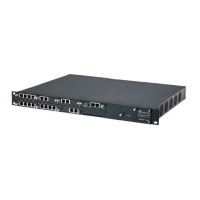Version 6.6 715 October 2014
Installation & Operation Manual 42. Stand-Alone Survivability (SAS) Application
42 Stand-Alone Survivability (SAS)
Application
This sectiion describes the Stand-Alone Survivability (SAS) application.
42.1 Overview
Stand-Alone Survivability (SAS) feature ensures telephony communication continuity
(survivability) for enterprises using hosted IP services (such as IP Centrex) or IP-PBX;
in cases of failure of these entities. In case of failure of the IP Centrex, IP-PBX servers
(or even WAN connection and access Internet modem), the Enterprise internal
telephony service at any branch is lost between its offices, and with the external
environment. In addition, these failures prevent emergency calls from being made
(e.g., 911 in North America). Despite these possible points of failures, the SAS feature
ensures that the Enterprise's telephony services (e.g., SIP IP phones or soft phones)
are maintained, by routing calls to the PSTN (i.e., providing PSTN fallback).
The maximum number of SAS registered users supported by the board is 2000.
Notes:
• The SAS application is available only if the board is installed with the SAS
Feature Key.
• The SAS feature is not HA supported.
42.2 SAS Modes
The SAS feature operates in one of two modes:
Normal: Initially, the device's SAS agent serves as a registrar (and an outbound
Proxy server) to which every VoIP CPE (e.g., IP phones) within the Enterprise's
LAN registers. The SAS agent at the same time sends all these registration
requests to the Proxy server (e.g., IP-Centrex or IP-PBX). This ensures
registration redundancy by the SAS agent for all telephony equipment. Therefore,
the SAS agent functions as a stateful proxy, passing all SIP requests received
from the Enterprise to the Proxy and vice versa. In parallel, the SAS agent
continuously maintains a keep-alive "handshake" with the Proxy server, using SIP
OPTIONS or re-INVITE messages.
Emergency: The SAS agent switches to this mode if it detects (from the
keep-alive responses) that the connection with the Proxy is lost. This can occur
due to Proxy server failure or WAN problems. In this mode, when the connection
with the Proxy server is down, the SAS agent handles all internal calls within the
enterprise LAN. In the case of outgoing calls, the SAS agent forwards these to a
local VoIP gateway (this can be the device itself or a separate analog or digital
gateway). For PSTN fallback, the local VoIP gateway should be equipped with
analog (FXO) lines or digital (E1/T1) trunk(s) for PSTN connectivity. In this way,
the enterprise preserves its capability for internal and outgoing calls.

